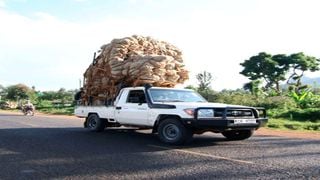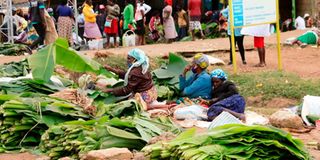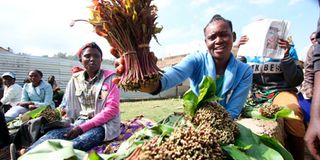Breaking: Autopsy reveals how Cyrus Jirongo died

A vehicle transporting miraa from Meru.
Meru
Premium
‘Green gold’: From boom to bust in less than a year
What you need to know:
- Truckloads of miraa pickers and graders zooming past the villages are now a thing of the past, a fact that has rendered thousands of youths jobless.
In Maua town, miraa traders’ chairman Mohamed Quresh says about 500 families whose heads were dependent on the fluid miraa export business, are now in need of food aid.
On this day last year, Kachiongo area in Maua town was a beehive of activity, with more than 5,000 traders rushing against time to deliver orders of miraa, fresh banana leaves for packaging, sacks and ropes to anxious khat exporters.
Water, juice, soda and food retailers who had set up business there were a busy lot, quenching the thirst and filling the empty stomachs of the traders.
Kachiongo enjoyed booming business propelled by the growth and sale of khat and was also the economic hub for shrewd Somali traders who have for years thrived in the miraa business. Apart from being big consumers themselves, the Somali traders are also khat middlemen.
On a good market day, this rugged section of Maua town could ship out miraa worth up to Sh40 million.

Women selling banana leaves for wrapping miraa at Maua market in Meru County on July 30, 2020. They have also been adversely affected by the ban of miraa sale in Somalia, one of the product's largest markets.
Somalia ban
But as the ban on miraa in Somalia — home to one of khat’s biggest markets — clocks a year in March, Kachiongo and Maua town by extension, have been hit hard by a shrinking economy that has left many staring at poverty.
The same fate has befallen Kanuni, Athiru, Kabuitu and Kanjoo areas, where the miraa variety preferred by the Somali market is grown.
The effects of the Somalia ban have reached everybody in the miraa micro-economy, from the big Somali traders to farmers and pickers, those who prepare it for market, the women who grow bananas solely for their leaves, which are used for wrapping the miraa, and truck loaders and drivers in direct employment.
Truckloads of miraa pickers and graders zooming past the villages are now a thing of the past — rendering thousands of young people jobless.
Mr Moses Lichoro, a farmer who owns 48 acres of miraa in Kabuitu, says about 50 people who used to work for him were rendered jobless. Mr Lichoro adds that he has experienced unprecedented losses since the miraa ban came into effect.

Women selling miraa in Maua town, Igembe South on December 09 2017. Residents who rely on the crop for survival are now seeking food aid after being hit hard by the khat sale ban in Somalia.
Life is too hard
“Before the market was shut, I would sell miraa worth more than Sh3 million every month during the high season. I can hardly get Sh10,000 now. Life is too hard for us,” he said.
Another farmer, Mr Jacob Miriti, says with the European and Somali markets gone, the only place left for him to sell the stimulant is the north eastern counties of Garissa, Mandera and Wajir, where consumers now dictate how much they pay — and it’s not much.
The price of a sack of miraa (100 bundles) has plummeted to Sh20,000.
“The sudden slump in income has caused a socio-economic shock in the region. Suddenly, someone who was making good money in a month is getting nothing. It is disastrous,” says Mr Miriti, a member of Nyambene Miraa Traders Association (Nyamita).

A grader works on the Maua-Kiegoi road on July 28, 2020. The road is crucial for miraa transport but the trade has now dwindled due to the ban in Somalia.
In need of food aid
In Maua town, miraa traders’ chairman Mohamed Quresh says about 500 families that were dependent on miraa export, are now in need of food aid.
Up to 6,000 people dealing in packaging, sale of sacks and banana leaves, transportation, grading and loading relied on the export market.
Mr Abdi Nur, who sells water and soft drinks, says business is at its lowest and stocks are hard to replenish.
The local mosque, he says, is overwhelmed as traders who used to make donations to the poor are now the ones in need of assistance.
“Before we lost the Somalia market, I was working with more than 70 people who were supplying me with miraa and other things. I could buy a plane-load of khat for export. All these people are now jobless,” Mr Quresh says.
So harsh is the impact of lost business that the Somali community has reached out to Igembe South deputy County commissioner and MP John Paul Mwirigi for food aid.
“We approached the DCC for food aid because there are many families going without food. Some children are not able to go to school due to lack of fees. Others have been locked out of their houses by landlords,” he says.
Mr Ahmed Osman, a miraa retailer, says he would make up to Sh8,000 on a good day.
“Today, it is a blessing if I manage Sh300. The loss is devastating,” he says.
With the hope of reopening the lucrative market waning following the political stalemate in Somalia, some residents are now looking for alternative ways of survival.
Sacco to pool resources
Pushed by the lost market, Mr Martin Mugambi, a miraa trader, and about 1,000 youth have formed Miraa Youth sacco to pool resources for affordable lending.
“I used to buy and sell miraa worth about Sh100,000 in a day, making up to Sh7,500 profit. All that is gone. This is why I joined hands with like-minded youth to form a sacco to enable us venture into small businesses. We are engaging experts to guide us on small businesses that can sustain us now,” Mr Mugambi says.
Through the sacco, they also hope to secure government grants, to support members through the financial crisis.
Mr Mithika Mwenda, a climate change activist, is also promoting adoption of sunflower farming to supplement the troubled miraa.
“Sunflower farming fits very well as it is drought resistant and has a guaranteed market. This will support farmers to supplement their food, nutrition and financial needs,” Mr Mwenda says.
Farmers and traders have called on President Uhuru Kenyatta to negotiate with the Somali government to lift the ban.
Nyamita Chairman Kimathi Munjuri says the stakeholders are suffering due to the impasse.
“We are losing over Sh16 million worth of exports daily and farmers are feeling the pinch. They are hard hit because the produce is wasting in farms yet there is a market,” Mr Munjuri says.
According to Mr Munjuri, the section that deals with miraa at the Agriculture, Food and Fisheries Authority (Affa) should incorporate players in the sector, and ministries of Trade, Foreign Affairs and Interior.
According to Igembe South MP John Paul Mwirigi, close to 80,000 residents are facing hunger due to poor harvest of food crops and dwindling miraa markets.
He said nearly half of the constituency’s 160,000 residents, mainly from the lower zones, had experienced insufficient rains and thus will have little to harvest.






